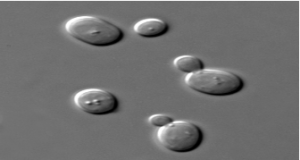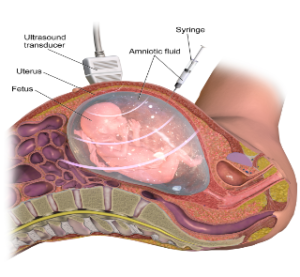B13.1 Types of Reproduction AQA GCSE Biology B13 Types of Reproduction: Kerboodle Answer
Page No. 197
1 Define the following:
Asexual reproduction is a type of reproduction by which offspring arise from a single organism, and inherit the genes of that parent only; it does not involve the fusion of gametes, and almost never changes the number of chromosomes.
Sexual reproduction is a form of reproduction where two morphologically distinct types of specialized reproductive cells called gametes fuse together, involving a female’s large ovum (or egg) and a male’s smaller sperm. Each gamete contains half the number of chromosomes of normal cells. They are created by a specialized type of cell division, which only occurs in eukaryotic cells, known as meiosis.
Gametes: a mature haploid male or female germ cell which is able to unite with another of the opposite sex in sexual reproduction to form a zygote.
variation: Variation, in biology, any difference between cells, individual organisms, or groups of organisms of any species caused either by genetic differences (genotypic variation) or by the effect of environmental factors on the expression of the genetic potentials (phenotypic variation).
2 In asexual reproduction, there is no fusion of gametes and only one parent. There is no mixing of genetic information, leading to genetically identical offspring. Because mitosis is involved in asexual reproduction. But in sexual reproduction involves the joining(fusion) of male and female gametes formed by meiosis. Meiosis leads to the formation of non- identical cells, sperm and eggs cell in animals and pollen and eggs cells in flowering plants.
3 Sexual reproduction
These are some of the advantages of sexual reproduction:
introduces variation into a population
the species can adapt to new environments
a disease is less likely to affect all the individuals in a population
These are some of the disadvantages of sexual reproduction:
time and energy are needed to find a mate
not possible for an isolated individual
Asexual reproduction
The advantages of asexual reproduction include:
population can increase rapidly
can exploit a suitable habitat quickly
The disadvantages include:
does not lead to variation in a population
the species may only be suited to one habitat
disease may affect all the individuals in a population
B13.2 Cell Division in Sexual Reproduction AQA GCSE Biology B13 Cell Division in Sexual Reproduction:Kerboodle Answer Page No. 199
a 23 pairs of chromosomes are there in a normal human body cell
b 23 pairs of chromosomes are there in a human sperm cell
c 23 pairs of chromosomes are there in a human fertilized cell
2 The process of sexual reproduction involves two parents, each contributing one gamete. Gametes are produced by a process called meiosis, which starts by the duplication of the chromosomes, followed by two rounds of cell divisions and halving of the chromosome number. Gametes have half the chromosome number of other adult cells of an organism.
the exchange of chromosome pieces which occurs in the first division of this process, called recombination or crossing over. Recombination is a very important source of genetic variation between individuals of sexually reproducing species, and the driving force for the process of natural selection.
CROSSING-OVER
When homologous chromosomes come together during prophase I of meiosis, they exchange bits of DNA with each other. This crossing-over results in new gene combinations and new chances for variety. Crossing-over is one way of explaining how a person can have red hair from his mother’s father and a prominent chin from his mother’s mother. After crossing-over, these two genes from two different people wound up together on the same chromosome in the person’s mother and got handed down together.
INDEPENDENT ASSORTMENT
Independent assortment occurs when homologous chromosomes separate during anaphase I of meiosis. When the homologous pairs of chromosomes line up in metaphase I, each pair lines up independently from the other pairs.
So, the way the pairs are oriented during meiosis in one cell is different from the way they’re oriented in another cell. When the homologous chromosomes separate, many different combinations of homologous chromosomes can travel together toward the same side of the cell.
3 a Meiosis is a process where a single cell divides twice to produce four cells containing half the original amount of genetic information. These cells are our sex cells – sperm in males, eggs in females.
- During meiosis one cell divides twice to form four daughter cells.
- These four daughter cells only have half the number of chromosomes of the parent cell – they are haploid.
Meiosis can be divided into nine stages. These are divided between the first time the cell divides (meiosis I) and the second time it divides (meiosis II):
Meiosis I
Interphase:
- The DNA in the cell is copied resulting in two identical full sets of chromosomes.
- Outside of the nucleus are two centrosomes, each containing a pair of centrioles, these structures are critical for the process of cell division
- Prophase I:
- The copied chromosomes condense into X-shaped structures that can be easily seen under a microscope.
- Each chromosome is composed of two sister chromatids containing identical genetic information.
- The chromosomes pair up so that both copies of chromosome 1 are together, both copies of chromosome 2 are together, and so on.
- The pairs of chromosomes may then exchange bits of DNA in a process called recombination or crossing over.
- At the end of Prophase I the membrane around the nucleus in the cell dissolves away, releasing the chromosomes.
- Metaphase I:
- The chromosome pairs line up next to each other along the centre (equator) of the cell.
- The centrioles are now at opposites poles of the cell with the meiotic spindles extending from them.
- The meiotic spindle fibres attach to one chromosome of each pair.
- Anaphase I:
- The pair of chromosomes are then pulled apart by the meiotic spindle, which pulls one chromosome to one pole of the cell and the other chromosome to the opposite pole.
- In meiosis I the sister chromatids stay together. This is different to what happens in mitosis and meiosis II.
- Telophase I and cytokinesis:
- The chromosomes complete their move to the opposite poles of the cell.
- At each pole of the cell a full set of chromosomes gather together.
- A membrane forms around each set of chromosomes to create two new nuclei.
- The single cell then pinches in the middle to form two separate daughter cells each containing a full set of chromosomes within a nucleus. This process is known as cytokinesis.
- Meiosis II
Prophase II:
- Now there are two daughter cells, each with 23 chromosomes (23 pairs of chromatids).
- In each of the two daughter cells the chromosomes condense again into visible X-shaped structures that can be easily seen under a microscope.
- The membrane around the nucleus in each daughter cell dissolves away releasing the chromosomes.
- The centrioles duplicate.
- The meiotic spindle forms again.
Metaphase II:
- In each of the two daughter cells the chromosomes (pair of sister chromatids) line up end-to-end along the equator of the cell.
- The centrioles are now at opposites poles in each of the daughter cells.
- Meiotic spindle fibres at each pole of the cell attach to each of the sister chromatids.
Anaphase II:
- The sister chromatids are then pulled to opposite poles due to the action of the meiotic spindle.
- The separated chromatids are now individual chromosomes.
Telophase II and cytokinesis:
- The chromosomes complete their move to the opposite poles of the cell.
- At each pole of the cell a full set of chromosomes gather together.
- A membrane forms around each set of chromosomes to create two new cell nuclei.
- This is the last phase of meiosis, however cell division is not complete without another round of cytokinesis.
- Once cytokinesis is complete there are four granddaughter cells, each with half a set of chromosomes (haploid):
- in males, these four cells are all sperm cells
- in females, one of the cells is an egg cell while the other three are polar bodies (small cells that do not develop into eggs).

b In male animals, meiosis takes place in the testes and in females within the ovaries.
c Meiosis is important because it ensures that all organisms produced via sexual reproduction contain the correct number of chromosomes. Meiosis also produces genetic variation by way of the process of recombination.
B13.3 The best of both Worlds AQA GCSE Biology B13 The best of both Worlds: Kerboodle Answer Page No. 201
1c Similarity between sexual and asexual reproduction is Offspring is produced as a result of both processes. Difference between asexual reproduction and sexual reproduction are: in sexual reproduction involves formation and fusion of gametes. But in asexual reproduction there is no formation and fusion of gametes.
2 a In plants, the flowers contain the organs of sexual reproduction. The gametes – the pollen and the egg cells – are produced using meiosis. The pollen from one flower must reach the female parts of another flower in a process called pollination -the plant equivalent of mating.
Many plants can also reproduce asexually. A new plant grows as a result of specially directed mitosis. Examples include the tiny new plants that form on the end of specialised stems called runners (e.g., strawberry plants and spider plants), and the division of bulbs in plants such as daffodils.
The most common form of reproduction in fungi is asexual. The parts you most commonly see, such as toadstoois and puffballs, are asexual fruiting bodies full of spares. The moulds that rot our food also reproduce asexually.
Many fungi are made up of a mass of thin threads called hyphae that together form the structures we can see. In asexual reproduction, the fungal spares are produced by mitosis and they are genetically identical to the parent
Some fungi also reproduce sexually when conditions are not good – for example, when it is dry.
b The parasites that cause malaria reproduce differently in different stages of their life cycle. As you know, malarial parasites spend part of their life cycle in the body of a female mosquito and part of their life cycle in the blood and organs of human beings.
Both asexual and sexual reproduction are part of the life cycle – asexual reproduction is not an alternative only if conditions are bad.
Malarial parasites reproduce asexually in human liver and blood cells.
When the mosquito takes her blood meal, the drop in temperature between the human body and the mosquito triggers sexual reproduction in some of the parasites inside the red blood cells.
There is a 20 minute window when sexual forms develop, burst out of the blood cells, and meet to form zygotes with two sets of chromosomes. These zygotes then undergo meiosis to produce new asexual parasites that will infect a new human host.
The most common form of reproduction in fungi is asexual. The parts you most commonly see, such as toadstoois and puffballs, are asexual fruiting bodies full of spares. The moulds that rot our food also reproduce asexually.
Many fungi are made up of a mass of thin threads called hyphae that together form the structures we can see. In asexual reproduction, the fungal spares are produced by mitosis and they are genetically identical to the parent
Some fungi also reproduce sexually when conditions are not good – for example, when it is dry.
3 Asexual reproduction advantages
- only one parent required to reproduce
- quicker than sexual reproduction
- there are many offspring in a short time
Asexual reproduction disadvantages
- offspring are all genetically identical and if conditions change and this kills one. all will potentially die because the species can not adapt
.
sexual reproduction advantages
- there is genetic diversity
- all individuals are genetically unique
- survival characteristics are passed on, so species can adapt
- If conditions change some may die but some may survive
sexual reproduction disadvantages
- two parents are required
- takes a long time and is hard work
- difficult to safely transfer sperms to egg cell
B13.4 DNA and the Genome AQA GCSE Biology B13 DNA and the Genome Kerboodle Answer Page No. 203
1 a the genome of an organism is the entire genetic material of that organism
b The genome of an organism is the entire genetic material of the organism. That includes all of the chromosomes, and the genetic material found in the mitochondria as well.
Mitochondria contain their own DNA. You always inherit your mitochondrial DNA from your mother because it comes from the mitochondria in the egg.
The human genome contains over 3 billion base pairs and almost 21 000 genes that code for proteins.
2a he Human Genome Project (HGP) was an international scientific research project with the goal of determining the sequence of nucleotide base pairs that make up human DNA, and of identifying and mapping all of the genes of the human genome from both a physical and a functional standpoint.
c Understanding the human genome is playing a massive part in the search for genes linked to different types of diseases. Understanding the human genome helps us to understand inherited disorders such as cystic fibrosis and sickle cell disease. The more we can understand what goes wrong in these diseases, the more chance we have of overcoming them either through medicines or by repairing the faulty genes.
ii Scientists are sequencing the genome of hundreds of different species of organisms. They use similarities and differences in the genome to help them work out the relationships between different types of organisms.
Sequencing the genomes of bacteria and viruses allow us to identify the cause of disease very rapidly and to choose the correct treatment.
Understanding the human genome helps us understand human evolution and history.
People all over the world can be linked by patterns in their DMA, allowing scientists to trace human migration patterns from our ancient history. We can also be linked to early members of the human family tree.
For example, most people have a small number of Neanderthal genes In their DNA, even though that branch of the human family died out around 40000 years ago.
B13.5 DNA Structure and Protein Synthesis AQA GCSE Biology B13 DNA Structure and Protein Synthesis: Kerboodle Answer Page No. 205
Define the following terms:
1 a In DNA, there are four different bases: adenine (A) and guanine (G) are the larger purines. Cytosine (C) and thymine (T) are the smaller pyrimidines.
b a Nucleotides are organic molecules that serve as the monomer units for forming the nucleic acid polymers deoxyribonucleic acid (DNA) and ribonucleic acid (RNA), both of which are essential biomolecules in all life-forms on Earth. Nucleotides are the building blocks of nucleic acids; they are composed of three subunit molecules: a nitrogenous base, a five-carbon sugar (ribose or deoxyribose), and at least one phosphate group. They are also known as phosphate nucleotides.
2 Proteins are large, complex molecules that play many critical roles in the body. They do most of the work in cells and are required for the structure, function, and regulation of the body’s tissues and organs.
Proteins are made up of hundreds or thousands of smaller units called amino acids, which are attached to one another in long chains. There are 20 different types of amino acids that can be combined to make a protein. The sequence of amino acids determines each protein’s unique 3-dimensional structure and its specific function.
There are many different types of proteins in our bodies. They all serve important roles in our growth, development and everyday functioning. Here are some examples:
Enzymes are proteins that facilitate biochemical reactions, for example, pepsin is a digestive enzyme in your stomach that helps to break down proteins in food.
Antibodies are proteins produced by the immune system to help remove foreign substances and fight infections.
DNA-associated proteins regulate chromosome structure during cell division and/or play a role in regulating gene expression, for example, histones and cohesin proteins
Contractile proteins are involved in muscle contraction and movement, for example, actin and myosin
Structural proteins provide support in our bodies, for example, the proteins in our connective tissues, such as collagen and elastin.
3 DNA is divided into functional units called genes. A gene is a segment of DNA that codes for a functional product (mRNA, tRNA, or rRNA). Since the vast majority of genes are transcribed into mRNA and mRNA is subsequently translated into polypeptides or proteins, most genes code for protein synthesis. Most of the time when a cell is not dividing, it is performing a series of activities under the control of the DNA in its nucleus. In order to do this, information from certain portions of the DNA in the chromosomes must be taken out into the cytoplasm, to be used to make (synthesise) control proteins (enzymes, etc) for the cell.
Protein Synthesis is divided in two parts:
- Transcription
Before the synthesis of a protein begins, the corresponding RNA molecule is produced by RNA transcription. One strand of the DNA double helix is used as a template by the RNA polymerase to synthesize a messenger RNA (mRNA). This mRNA migrates from the nucleus to the cytoplasm. During this step, mRNA goes through different types of maturation including one called splicing when the non-coding sequences are eliminated. The coding mRNA sequence can be described as a unit of three nucleotides called a codon.
- Translation
The ribosome binds to the mRNA at the start codon (AUG) that is recognized only by the initiator tRNA. The ribosome proceeds to the elongation phase of protein synthesis. During this stage, complexes, composed of an amino acid linked to tRNA, sequentially bind to the appropriate codon in mRNA by forming complementary base pairs with the tRNA anticodon. The ribosome moves from codon to codon along the mRNA. Amino acids are added one by one, translated into polypeptidic sequences dictated by DNA and represented by mRNA. At the end, a release factor binds to the stop codon, terminating translation and releasing the complete polypeptide from the ribosome
B13.6 Gene Expression and Mutation AQA GCSE Biology B13 Gene Expression and Mutation : Kerboodle Answer Page No. 207
1 a Gene expression is the process by which information from a gene is used in the synthesis of a functional gene product. These products are often proteins, but in non-protein coding genes such as transfer RNA (tRNA) or small nuclear RNA (snRNA) genes, the product is a functional RNA.
b All cells contain a set of genes, which can be thought of as a set of instructions for making each of a very large number of proteins . The creation of a protein from its gene is called gene expression.
Controlling gene expression is critical to a cell because it allows it to avoid wasting energy and raw materials in the synthesis of proteins it does not need. Thus, it allows a cell to be a more streamlined and versatile entity that can respond to changing conditions by adjusting its physiology.
To understand the control of gene expression, two key concepts should be understood. First, gene expression requires transcription , the process of making a messenger ribonucleic acid (mRNA) copy of the deoxyribonucleic acid (DNA) gene. Transcription can only occur if RNA polymerase first attaches, or binds, to the DNA. Controlling this binding process is the major way that gene expression is controlled, and proteins are the major controllers of binding.
The second important concept is that a protein molecule that helps regulate binding can itself be regulated. This usually occurs when some other molecule binds to the protein, causing the protein to undergo a structural change, in other words, to change shape. In some cases this shape change will help RNA polymerase to bind to DNA, and in other cases it will prevent it from doing so.
2 Mutations can affect an organism by changing its physical characteristics (or phenotype) or it can impact the way DNA codes the genetic information (genotype). When mutations occur they can cause termination (death) of an organism or they can be partially lethal. This means that the organism has difficulty adapting to and surviving in its environment.
Mutations are usually the cause of many diseases and defects in an organism’s life.
Mutations can occur in two ways: spontaneously or by agents known as mutagens. Spontaneous, or random, mutations occur because molecules are constantly moving inside a cell, which can cause collisions. These collisions can cause interruptions in DNA replication which can result in damage of DNA information. Also, because DNA is such a complex molecule, mutations can occur without any outside influences. However, there are some other factors that influence the occurrence of a mutation. A mutagen is an abnormal factor that changes genetic information. Mutagens are substances such as x-rays, ultra-violet radiation, and chemicals that come from cigarette smoke.
3 A mutation is a natural change in genetics. A mutation may create variety for an organism, or it may be a negative error in basic genetic makeup.
Explanation:
A mutation can occur on its own. If an organism lives with its mutation to reproduce, it has a chance of passing its mutation on to offspring. If the mutation is truly helpful, the organism will live with it until reproduction. More and more of the species will inherit the genes, and eventually the “mutated” population of the species will outnumber the “normal” population, further increasing chances that more of the organism will have the genes.
For instance, a group of brown beetles blend into a brown tree. A beetle spawns that is white. It is easily seen by predators against the brown background, and is quickly eaten by a bird. This mutation is NOT helpful. However, one beetle spawns that is brown with black spots on it, which just so happens to simulate fungus on a tree, further helping it blend in.
It survives long enough to mate, passing on its genes to its offspring. More and more offspring survive to reproduce compared to the rate at which the “regular” brown beetles do. Eventually, the spotted beetles outnumber the regular beetles.
A mutation might also be a simple mistake in genetics. A beetle might be spawned without a vital organ, due to a mistake in a gene
B13.7 Inheritance in Action AQA GCSE Biology B13 Inheritance in Action : Kerboodle Answer Page No. 207
1 a A dominant allele produces a dominant phenotype in individuals who have one copy of the allele, which can come from just one parent.
b a recessive allele to produce a recessive phenotype, the individual must have two copies, one from each parent.
c a character is represented in an organism by at least two factors. The two factors lie on the two homologous chromosomes at same locus. They may represent the same( homozygous, TT in case of pure tall pea plants, tt in case of dwarf pea plants) or alternate expression ( heterozygous, Tt in case of hybrid tall tea pea plants) of the same character.
2 A a

AA = Dangly earlobe Aa = Dangly earlobe aa = attached earlobes |
B13.8 More about Genetics AQA GCSE Biology B13 More about Genetics : Kerboodle Answer Page No. 211
1 A XX
B XY
2 Since the alleles for different characters assort randomly from one another, probability can be used to mathematically predict the outcomes of genetic crosses involving one or more characters. Although Punnett squares are an effective and straightforward way to examine simple genetic crosses, they are unwieldy and time consuming when the inheritance of multiple characters is examined. A more effective way to examine inheritance is to use two basic laws of probability (The Rule of Multiplication and The Rule of Addition) to determine the probabilities mathematically.
An offspring’s genotype is the result of the combination of genes in the sex cells or gametes (sperm and ova) that came together in its conception. One sex cell came from each parent. Sex cells normally only have one copy of the gene for each trait (e.g., one copy of the Y or G form of the gene in the example above). Each of the two Punnett square boxes in which the parent genes for a trait are placed (across the top or on the left side) actually represents one of the two possible genotypes for a parent sex cell. Which of the two parental copies of a gene is inherited depends on which sex cell is inherited–it is a matter of chance. By placing each of the two copies in its own box has the effect of giving it a 50% chance of being inherited.

Genotype
7:2:4:3- Orange female: Orange male: White female: white male
Phenotype-9 orange 7 white
B13.9 Inherited Disorders AQA GCSE Biology B13 Inherited Disorders : Kerboodle Answer Page No. 213
1 a Sometimes babies are born with extra fingers or toes. This is called polydactyly.The most common form of polydactyly is caused by a dominant allele. It can be inherited from one parent who has the condition.
b If you have polydactyly and are heterozygous, you have a 50% chance of passing on the disorder to any child you have. That’s because half of your gametes will contain the faulty dominant allele. If you are homozygous, your children will definitely have the condition.
b Cystic flbrosis is caused by a recessive allele so it must be inherited from both parents. Children affected by cystic fibrosis are usually born to parents who do not suffer from the disorder. The parents have a dominant healthy allele, which means their bodies work normally. However, they also carry the recessive cystic fibrosis allele. Because it gives them no symptoms, they have no idea it is there. They are known as carriers.
c Cystic flbrosis is caused by a recessive a!le!e so it must be inherited from both parents.
Children affected by cystic fibrosis are usually born to parents who do not suffer from the disorder.
The parents have a dominant healthy allele, which means their bodies work normally. However, they also carry the recessive cystic fibrosis allele. Because it gives them no symptoms, they have no idea it is there. They are known as carriers.
B3.10 Screening for Genetic Disorders AQA GCSE Biology B13 Screening for Genetic Disorders : Kerboodle Answer Page No. 215
1 To screen an embryo or fetus, you first need to harvest some cells from the developing individual. There are two main methods by which this is done once pregnancy is underway – amniocentesis and chorionlc villus sampling.
- Amniocentesis is carried out at around 15-16 weeks of pregnancy. It involves taking some of the fluid from around the developing fetus. This fluid contains fetal cells, which can then be used for genetic screening.
- Chorionicvillus sampling of embryonic cells is done at an earlier stage of pregnancy – between 10 and 12 weeks – by taking a small sample of tissue from the developing placenta. This again provides fetal cells to screen. Both of these tests have an associated risk of causing a miscarriage, but are currently the main methods used to obtain fetal cells for screening. Hew methods that depend on analysing fetal cells found in the blood of the mother offer the promise of much less invasive testing in future.
- Another alternative taken by some couples with an inherited disorder in the family is for embryos produced by IVF to be tested before they are implanted in the mother, so only babies without that disorder are born.
2 Describe the steps involved in carrying out genetic screening of;
a Amniocentesis is carried out at around 15-16 weeks of pregnancy. It involves taking some of the fluid from around the developing fetus. This fluid contains fetal cells, which can then be used for genetic screening
b Another alternative taken by some couples with an inherited disorder in the family is for embryos produced by IVF to be tested before they are implanted in the mother, so only babies without that disorder are born.
3 There are several concerns linked to the process.
- The processes used to collect cells from a developing fetus increase the risk of miscarriage.
- So, in some cases, a healthy fetus will be mlscarried as a result of a test to see whether it has a genetic abnomnality, which is obviously very distressing for the parents.
- The screening procedures are becoming more reliable and accurate all the time, but sometimes they can still give a false positive or a false negative result.
- This can, very occasionally, lead to the termination of a healthy pregnancy or the unexpected birth of a child with a genetic disorder.
- Embryo screening also means that people have to make decisions about whether or not to terminate a pregnancy. This is never an easy decision.
AQA GCSE Biology B13 Reproducation Summary questions Kerboodle Answer Page No. 216
1 a from runners,
special stems from parent plant with small new identical plant at end
b asexual
c sexual reproduction,
pollination of egg cells in one flower by pollen from another
d New plants from packet will be similar to but not identical to their parents,
each one will be genetically different due to meiosis in producing gametes and fertilisation introducing variation.
Plants produced by asexual reproduction will
e advantages of sexual reproduction:
mixes genes, leads to variation, allows evolution, increases chances of species surviving if environment changes;
disadvantages of sexual reproduction:
need to find a partner, risk of gametes not finding each other, generally slower and fewer offspring;
advantages of asexual reproduction:
only involves one parent, simple and efficient, genes and characteristics conserved;
disadvantages of asexual reproduction:
no genetic variety (only produces clones), no evolution through natural selection.
2 a special form of cell division in which chromosome number is halved,
takes place in reproductive organs (ovaries and testes)
b It produces gametes in which chromosome number is reduced by half so that when gametes fuse in sexual reproduction
offspring have normal full number of chromosomes.
c
3 a sex cell
b Gamete contains half the number of chromosomes of normal body cell.
4 Many human features are the result of different genes interacting, but there are some that are the result of single gene inheritance.
a dominant phenotype:
characteristic seen even if allele coding for it present only on one chromosome in a pair;
recessive phenotype:
characteristic only present if coded for on both chromosomes in a pair
b dimples, dangly earlobes, straight or curved thumbs, black/brown coat colour in mice, red/green colour blindness, cystic fibrosis, polydactyl
c Cystic fibrosis is recessive phenotype.
Faulty allele must be present on both chromosomes in a pair for child to have the disease,
so one faulty allele must be inherited from each parent.
d An individual can be a carrier (with one allele for recessive condition) but not be aware of it because they also have an allele for the dominant, healthy phenotype
and so have no symptoms of disease.
e Both parents hererozygotes Ff
offspring genotypes: 1 FF, 2 Ff, 1 ff; offspring phenotypes: 3 normal, 1 cystic fibrosis
f Huntington’s disease phenotype is dominant (H).
An affected individual can only pass on dominant allele to offspring.
If affected individual is homozygous (HH), all offspring will be affected.
If affected individual is heterozygous (Hh), 1 in 2 offspring will be affected.
Because symptoms do not emerge until middle age, affected individual could have offspring before becoming aware of disease.
5 a Sami’s alleles are ss.
We know this because she has curved thumbs, which is recessive phenotype. She must have inherited two alleles for recessive characteristic.
b i Josh’s alleles are Ss.
The baby has inherited an allele for the recessive characteristic from each parent, so Josh must have a recessive allele. We know he also has a dominant allele as he has straight thumbs.
ii
6 mutation/particular conditions in which it was grown/any other sensible answer
B i Compare the expected ratio of phenotypes suggested by the genetic diagram in
Both parent plants must have had recessive white allele (one homozygous, one heterozygous):
b ii Actual results (295:102)
very close
to expected ratio of 3:1 white flowers:purple flowers (1 PP, 3 pp).
c i cross purple flowers
with white flowers (pp)
ii If purple flowers homozygous PP, all offspring will be purple (Pp).
If purple flowers heterozygous Pp, half offspring will be purple (Pp)
and half white (pp).
AQA GCSE Biology B13 Reproducation Practice questions Kerboodle Answer Page No.217
01 Sickle cell anaemia is an inherited disorder that causes red blood cells to develop abnormally.
Figure 1 shows a normal red blood cell and a sickle red blood cell.

Sickle red blood cells cannot carry out their function properly.
01.1 lack of energy
- shortness of breath
- tiredness
01.2 Figure 2 shows a family tree. Some members of this family have sickle cell anaemia.

neither of Max’s / Clara’s parents have the disorder
01.3 h can be used to represent the recessive allele for sickle cell anaemia.
H can be used to represent the dominant allele for healthy red blood cells.
Tim: Hh
Sally: Hh
01.4 gametes shown
correct genotypes for offspring derived from their gametes
Tim identified as hh
- 01.51 out of 4
- 1/4
- 25%
02 Strawberry plants can reproduce both sexually and asexually.
02.1 pollen
egg (cell)
02.2 produced from different gametes / pollen and egg cells
(so) have different genetic material / genes / DNA
02.3 produce runners
02.4 sexual reproduction:
- produces variation in the offspring
- survival advantage if environment changes
asexual reproduction:
- only one plant needed
- faster than sexual reproduction
- many identical new plants can be produced
02.5 Figure 3 shows the scientists’ results.

a (sudden) change in a gene / chromosome / DNA
02.6 as dose of X-rays increases rate of mutation increases
mutations occur without exposure to X-rays
03 The genetic material of a cell is composed of a chemical called DHA. Figure 4 shows part of a DHA molecule, with a section enlarged.

is a polymer
- made up of two strands
- a double helix
- consists of sugar molecules
- (and) phosphate groups
- alternating sugar and phosphate
- base attached to sugar
- bases are A, C, G or T
- sequence of nucleotides
- nucleotide is made up of a sugar, phosphate and a base
Banner 2
Disclaimer: I have tried by level best to provide the answers and video explanations to the best of my knowledge. All the answers and notes are written by me and if there is any similarity in the content then it is purely coincidental. But this is not an alternative to the textbook. You should cover the specification or the textbook thoroughly. This is the quick revision to help you cover the gist of everything. In case you spot any errors then do let us know and we will rectify it.
References:
BBC Bitesize
AQA GCSE Science Kerboodle textbook
Wikipedia
Wikimedia Commons
Join Our Free Facebook Group : Get A* in GCSE and A LEVEL Science and Maths by Mahima Laroyia: https://www.facebook.com/groups/expertguidance.co.uk/
For Free Tips, advice and Maths and Science Help
This page contains the detailed and easy notes for AQA GCSE Biology Ecology for revision and understanding Ecology.
Banner 1
New (9-1) AQA GCSE Biology Paper 2: Complete Revision Summary
INHERITANCE, VARIATION AND EVOLUTION
Banner 2
4.6 Inheritance, Variation and Evolution
- Sexual and Asexual Reproduction
- Meiosis
- DNA
- Mutation
- Inheritance
- Genetic Diseases
- Sex Determination
- Variation
- Evolution
- Selective Breeding
- Genetic Engineering
- Speciation
- Theories of Evolution
- Speciation
REPRODUCTION – Making more offspring’s
Reproduction is a process in which organisms produce young–ones of the same species. It is one of the fundamental characteristics of living organisms.
SEXUAL
| ASEXUAL
|
| Involves meiosis | Involves mitosis |
| Require both parents and involve fusion of gametes | Require single parent and no fusion of gametes |
| The offsprings are not genetically identical. | The offspring are clone and genetically identical. |
| Produce Variation and lead to evolution | No Variation and Evolution |
| eg human reproduction | eq budding in yeast, cutting, runners in plants |
MEIOSIS
Meiosis is the division of a germ cell that involves two fissions of the nucleus and gives rise to four gametes, or sex cells, each with half the number of chromosomes of the original cell.
- a) It takes place in the sex cells
- b) It is involved in the production of gametes
- c) One parent cell divide to form four daughter cells
- d) Daughter cells are not genetically identical to the parent.
- e) Daughter Cells have half the number of chromosome than the parent.
- f) It produces Variation as it results in crossing over and it leads to evolution.
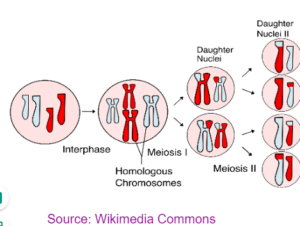
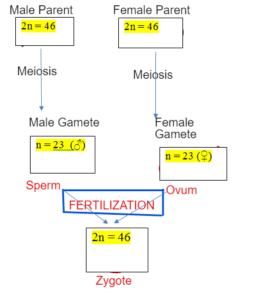
REPRODUCTIVE CYCLE IN FUNGI
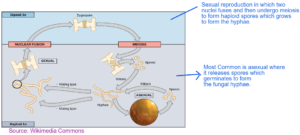
REPRODUCTIVE CYCLE IN PLANTS
Sexual reproduction involves the fusion of pollen grain with the egg nuclei forming zygote which forms the seeds and germinate to form a new plant.
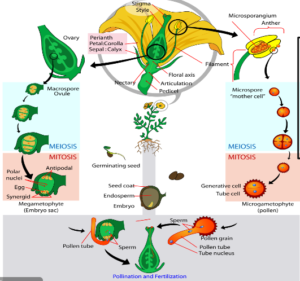

Sexual reproduction in plants in the form of runner, stolon or tuber which produces genetically identical plants.
REPRODUCTIVE CYCLE IN MALARIA
Liver Cell
- Asexual reproduction to form lot of malarial parasite spores
Blood Cells
- Formation of male and the female gamete of the parasite.
Mosquito
- Sexual reproduction in the mosquito forming zygotes and it divides to form spores of pathogens which enters saliva and then is injected into healthy person.
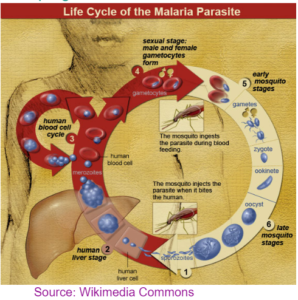
DNA – Deoxyribonucleic acid
Deoxyribonucleic acid (DNA) is a large macromolecule made up of a large number of monomeric units of nucleotides. Each nucleotide is composed of nucleoside and a phosphate group
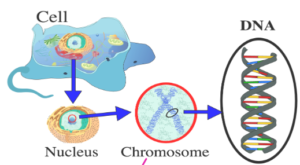
Chromosome – These are the structure that holds our genetic information
DNA – Double Helical Structure which contains genetic information
Gene – It is the segment of DNA that code for protein
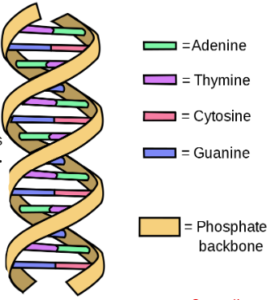
DN
DNA : A POLYNUCLEOTIDE
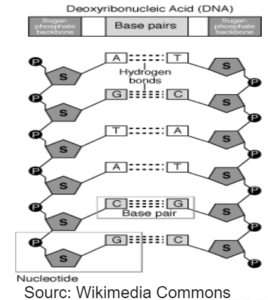
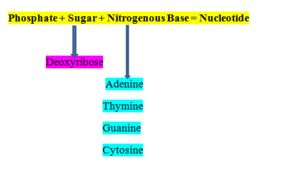
HUMAN GENOME
- Genome is the complete genetic materials of the organism.
- International collaboration to sequence around three billion bases and more than 20,000 genes.
Importance of Human Genome Project
- a) Understanding of genetic Diseases and inherited disorders
- b) Better personalised medicines
- c) Understanding Evolution
- d) Indentifying new drugs target.
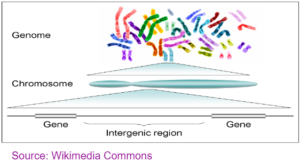
PROTEIN SYNTHESIS
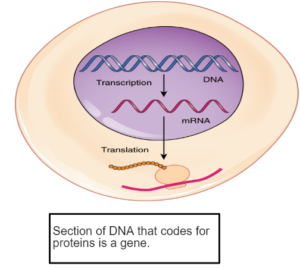
- The DNA copies the code and form mRNA by the process of transcription.
- The mRNA leaves the nucleus and reaches the ribosome.
- The ribosomes reads the bases in the sequence of three bases. The t-RNA brings the corresponding amino acid and forms polypeptide chain .
- The polypeptide chain than forms proteins.
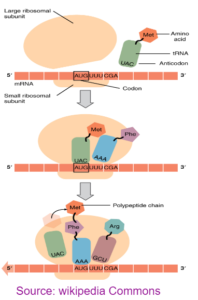
Mutations
- Can be silent, harmful or beneficial
A change in sequence of a gene or DNA
Results in the change in the sequence of the mRNA
Result in the change in amino acid
Result in the formation of non-functional protein or enzyme.
Change the structure of protein, the active site substrate can no longer fit into it

Banner 3
GENETIC TERMS
Chromosome – These are the structure that holds our genetic information
DNA – Double Helical Structure which contains genetic information
Gene – It is the segment of DNA that code for protein
Allele – the alternative factors located at the same locus on homologous chromosomes are called alleles.
Dominant Allele – It is able to express itself even in the presence of its recessive allele.
Recessive Allele – Unable to express its effect in the presence of dominant allele.
Homozygous – individual which contains identical genes or factors of a character on its homozygous chromosomes. E.g TT or tt
Heterozygous – individual which contains the two different or contrasting factors, genes or alleles of a character on its homologous chromosomes. e.g Tt
Genotype – It is the gene complement or genetic constitution of an individual with regard to one or more characters irrespective of whether the genes are expressed or not.
Phenotype – It is the external manifestation of gene products brought to expression
Punnett Square – It is a checker board used to show the result of a cross between two organisms.
Banner 4
Genetic Cross
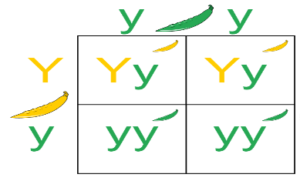
Heterozygous yellow plant with green plant.
Dominant: yellow Y
Recessive –green y
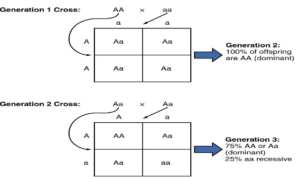
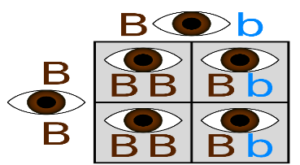
Heterozygous brown eyes with homozygous brown eyes.
B: Brown =Dominant
b: Blue: =Recessive
SEX DETERMINATION
Females XX
Male XY
50% changes of the offspring to be male or female
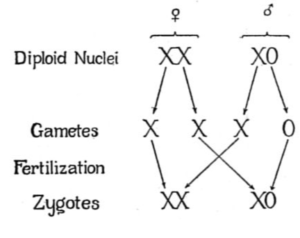
Banner 5
POLYDACTYLY
- Caused by dominant Allele
- If one of the parent has the allele offspring will have a disease.
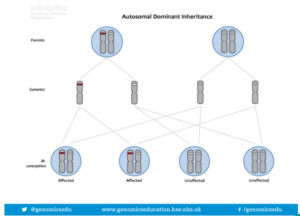
GENETIC DISORDER
- Caused by recessive allele
- Both the parent should have the allele to infect the offspring.
- The mucous becomes sticky and thick.
- It blocks the airways, reproductive tract and digestive tract.
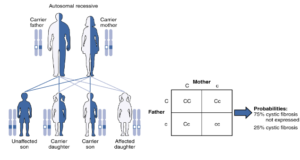
Baneer 6
GENETIC SCREENING
- Provides genetic counselling to the couple and helps to diagnose any problem before birth.
Amniocentesis
- Done at later stages Taking amniotic fluid which has fetal cells .
- The cells are then screened for genetic disorders.
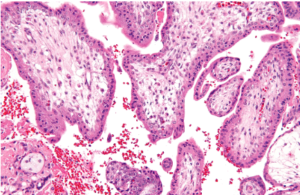
- Chorionic Villi Sampling
- Done at early stage and involve taking fluid from the placenta which contains fetal cells.
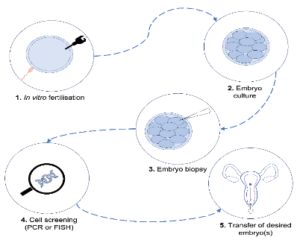
Banner 7
IVF Screening
Involves screening of the embryo after in vitro fertilization.
VARIATION – Differences amongst the individual
| CONTINIOUS VARIATION | DISCONTINOUS VARIATION |
| It is environmental like height, weight. | It is genetic like blood group. |
| Graph is a bell shaped curve | Graph is like column graph having descrete values. |
Natural Selection
“Natural selection is the differential survival and reproduction of individuals due to differences in phenotype. It is a key mechanism of evolution, the change in the heritable traits characteristic of a population over generations.”- Wikipedia
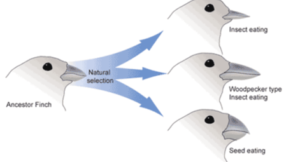

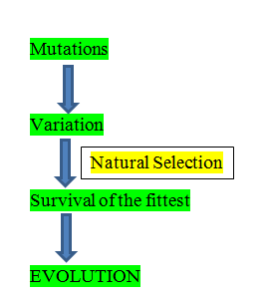
SELECTIVE BREDDING
- Artificially mating the two desirable characters parents to produce required offspring and selecting the ones with the best characteristics.
Applications
- a) Producing high milk yielding cow
- b) Producing diseases resistance and high yield crops.
DISADVANTAGES
- a) Slow process
- b) Time consuming
- c) Causes reduction in gene pool
- d) Undesirable traits can also get selected.
- e) A disease can result in elimination of whole population
Banner 8
GENETIC ENGINEERING
- Altering the gene by inserting the desired gene to produce genetically modified organisms.
- Isolation
- Inserting the gene with the vector (plasmid) to form recombinant DNA
- Introducing the recombinant into bacteria – Transformation
- Selecting transformed bacteria
- Growing transformed bacteria
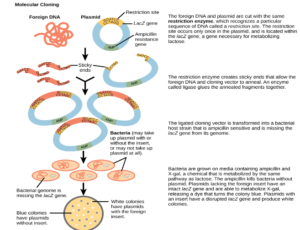
GENETIC ENGINEERING
Examples
- a) Tomato with greater shelf life
- b) Golden Rice which is rich in Vitamin A
- c) Gentically engineered Insulin
- d) Disease resistant crops
- e) Insects resistant crops
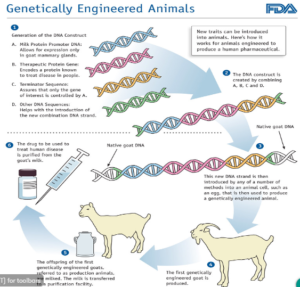
CLONING
- Taking Explant
- Growing and multiplying it in the nutrient medium
- Nutrient medium has all the hormones and minerals
- The new tiny plantelets formed are grown in the field

ADULT CELL CLONING
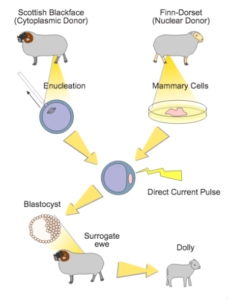
Banner 9
GENETIC ENGINEERING DEBATE
ADVANTAGES
- a) Produce Genetically Engineered crops which are high yielding
- b) Produce nutrient rich crops
- c) Produce high meat and high milk producing cows.
- d) Cure genetic disorders
- e) Can be used to produce medicines
- f) Can be used to produce food through microorganisms.
DISADVATANGES
- a) Reduce genetic diversity and variety
- b) Can result in sterile offspring
- c) Faulty genes or traits can also be transmitted
- d) It is expensive
- e) Ethical and religious concerns of playing with the nature.
- f) It is irreversible
GREGOR MENDEL
Genes Protein Expression
- In the 19th Century
- Father of Genetics
- He studied inheritance pattern in the pea plant
- He said that certain characters are inherited from one generation to another.
- In the 20th Century, the structure of DNA and the genes were discovered to build on Mendel Ideas
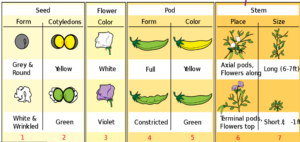
LAMARCK THEORY
Theory of Use and Disuse- If any characters in used it will develop and will be inherited others will be lost.
Example
- a) Giraffe had short necks and use to eat the grass
- b) As all grass were eaten away the giraffe stretched its neck to reach trees.
- c) The necks was used more and developed long necks
- d) The giraffe now acquired long necks.
Not all characters are inherited. Like Einstein did not give birth to an Einstein.
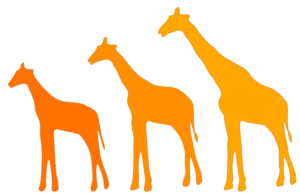
CHARLES DARWIN THEORY OF EVOLUTION
- Each Organism has potential to reproduce more than an environment can sustain
- The population remains constant due to natural selection
- Organisms show variation and nature selects the one which has desired characterstics.
- The one with desired characters survive and reproduce: Survival of the fittest
- The fittest one reproduce and pass the traits to next generation
EVOLUTION
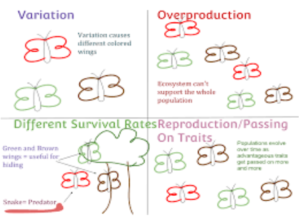
SPECIATION
Formation of new species
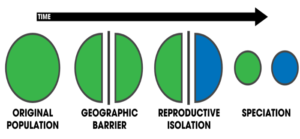
EVIDENCE OF EVOLUTION – FOSSILS
What are Fossils ?
- Fossils are the preserved remains of dead plants and animals that existed millions of years ago.
- Impressions, tracers or foot prints on the rocks are also considered as fossils.
How are Fossils formed ?
- They are formed by incomplete decay of the dead organsims due to hostile conditions for the decomposers.
- The harder part are replaced by minerals and are preserved as rock Impression on mud or rocks
Advantages
- Can give the information about extinct species.
- It can give the information about Evolution.
- Problems with Fossils
- Most of the animals that are soft bodies have no fossils
- Some of the fossils are yet to be discovered.
- No fossil record for some species’
FOSSILS AS EVIDENCE OF EVOLUTION
- Horse fossils record gives us the evidence of evolution
- From five digits it has developed hoofed limb and adapted to run on hard ground
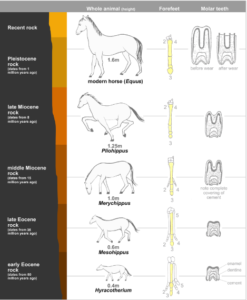
EXTINCTION
It the permanent loss of species
Causes
- a) Environmental Changes
- b) Diseases
- c) Predator
- d) Competition
- e) Catastrophic Event
Banner 10
CLASSIFICATION
Organising the species into groups according to the similar characterstics.
Advantages
- a) Helps to study the organisms easily
- b) Easy to identify unknown species
Basis
- a) Earlier organisms were classified on the basis of obeservable Characteristics
- b) Evolutionary Relationship
- c) DNA or protein sequencing
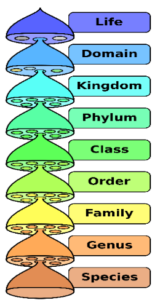
BINOMIAL NOMENCLATURE
- Each species is given two name
- The first name is Genus and is always capital
- The second name is species and it is written in lower case
- The name is italicised and if handwritten is underlined.
Homo sapiens
Genus name species name
- Universally accepted
- Helps the scientists to communicate
THREE DOMAIN CLASSIFICATION
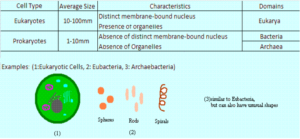
Banner 11
KEY TERMS
Asexual Reproduction – When offspring is produced by a single parent with or without the involvement of gamete formation, the reproduction is called Asexual.
Sexual Reproduction – Development of new individuals through the formation and fusion of male and female gametes.
Mitosis – Mitosis is a process of cell division that results in the development of two genetically identical daughter cells from a single stem cell.
Meiosis – Meiosis is the division of a germ cell that involves two fissions of the nucleus and gives rise to four gametes, or sex cells, each with half the number of chromosomes of the original cell.
Fertilization – Fusion of male and female gamete.
Variation – Variations are the differences found amongst individuals of the same species, race and family.
Natural Selection – Natural selection is the process in which organisms with favorable traits are more likely to reproduce.
Genome – It is a complete set of chromosomes when every gene chromosome is represented singly as in a gamete.
DNA – Double Helical Structure which contains genetic information
Chromosome – These are the structure that holds our genetic information
Allele – the alternative factors located at the same locus on homologous chromosomes are called alleles.
Nucleotide – A nucleotide is an organic molecule that is the constitutive element of DNA and RNA.
Transcription – formation of RNA or ribonucleic acid over DNA template is called transcription.
Translation – It is the process by which linear sequence of nucleotides or codons in a molecule of mRNA directs the specific linear sequence of amino acids in apolypeptide.
Gene Expression – A mechanism by which a gene is able to express itself in the phenotype of an organism.
Mutations – a new sudden inheritable discontinuous variation which is caused by a change in the nucleotide number, type and sequence of a DNA segment representing a gene or cristron.
Homozygous – individual which contains identical genes or factors of a character on its homozygous chromosomes. E.g TT or tt
Heterozygous – individual which contains the two different or contrasting factors, genes or alleles of a character on its homologous chromosomes. e.g Tt
Genotype – It is the gene complement or genetic constitution of an individual with regard to one or more characters irrespective of whether the genes are expressed or not.
Phenotype – It is the external manifestation of gene products brought to expression
Dominant Allele – It is able to express itself even in the presence of its recessive allele.
Recessive Allele – Unable to express its effect in the presence of dominant allele.
Punnett Square – It is a checker board used to show the result of a cross between two organisms.
Sex determination – It is a mechanism which brings about differentiation of sex, i.e, male and female, amongst organisms.
Cystic Fibrosis – Cystic fibrosis is an inherited disorder characterized by the accumulation of thick and sticky mucus that can damage many organs in the body.
Embryo Screening – a single cell is removed from an embryo two or three days after it has been conceived through in vitro fertilization and tested for genetic abnormalities.
Genetic Engineering – Genetic engineering refers to the direct manipulation of DNA to alter the characteristics of an organism (phenotype) in a particular way.
Variation – Variations are the differences found amongst individuals of the same species, race and family.
Evolution – Evolution is the change in the inherited traits of a population from generation to generation.
Natural Selection – Natural selection is the process in which organisms with favorable traits are more likely to reproduce.
Cloning – The term cloning describes several processes that can be used to produce genetically identical copies of a biological entity.
Tissue Culture – the process or technique for growing body tissue in a culture medium outside the body
Genetics – Study of heredity and variation in biological systems is called genetics.
Speciation – formation of new species.
Fossils – A fossil is the hard residue of a plant or a prehistoric animal that is found inside a rock.
Classification – classification is a mode of arranging organisms into categories according to a systematic plan as per nomenclature system.
Domain – Highest taxonomic rank of organisms in the three-domain system of taxonomy
Kingdom – It is the highest category of taxonomic studies.
Banner 12
Disclaimer:
I have tried my level best to cover the maximum of your specification. But this is not the alternative to the textbook. You should cover the specification or the textbook thoroughly. This is the quick revision to help you cover the gist of everything. In case you spot any errors then do let us know and we will rectify it.
References:
BBC Bitesize
Wikipedia
Wikimedia Commons
Image Source:
Wikipedia
Wikimedia
Commons
Flickr
Pixabay.
Make sure you have watched the above videos and are familiar with the key definations before trying these questions. It is also good to time yourself while doing these questions so that you can work on the speed as well.


